Service Alert
July 1 - Canada Day
CELA will be closed on Tuesday, July 1st for Canada Day. Our office will reopen and our Contact Centre services will resume on Wednesday, July 2nd. Enjoy your holiday!
CELA will be closed on Tuesday, July 1st for Canada Day. Our office will reopen and our Contact Centre services will resume on Wednesday, July 2nd. Enjoy your holiday!
Showing 1 - 20 of 8065 items
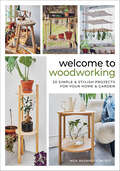
By Moa Brännström Ott. 2025
Learn the basic carpentry skills needed to furnish your home and garden with beautiful and useful wood items. Twenty accessible,…
step-by-step projects guide you through the essential techniques without large power tools. This book contains practical knowledge, including • how to choose good types of wood and the characteristics of the wood, • a tool review with an emphasis on hand tools, and • the methods used to measure, saw, plan, join, carve, and finish your wood creations. The projects feature clean, modern designs, including knife racks, cutting boards, shelves, stools, bookends, and benches. For those interested in gardening, there are flower tables, plant trellises, and more. The projects include easy-to-follow diagrams, and the levels of difficulty are adapted to readers who aren't used to working with wood, but who like its organic feel and expression. Explore the skills and techniques that make home carpentry a fun and rewarding craft.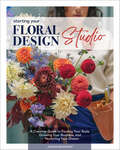
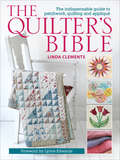
By Linda Clements. 2011
An essential reference with a collection of projects to inform and inspire quilters. This book presents essential know-how—together with…
a wide range of inspirational projects, tips, and ideas collected from international top-name quilters. Ideal for both beginners looking for trustworthy advice in a single volume and committed quilters searching for authoritative reference on seldom-used techniques, it features over fifteen projects including cot quilts, bed quilts, lap quilts, bags, cushions, wall hangings, table mats, runners, and other beautiful projects for the home. Includes color photos and illustrations.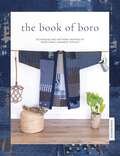
By Susan Briscoe. 2020
A collection of boro-inspired projects and techniques which celebrate this traditional Japanese textile and its relevance to the modern sewer…
and quilter.The word boro comes from the Japanese boroboro meaning something tattered or repaired. It refers to textiles that have been mended or patched together for utilitarian, not decorative, purposes to make the fabric stronger and warmer, and to mend torn and threadbare areas.The techniques section includes a short stitch directory with traditional stitches (running stitch and applique) and contemporary stitches (herringbone stitch, blanket stitch, chain stitch and whipped running stitch). Other techniques include instructions on improvisational patchwork; applique: raw, turned edge and reverse; darning techniques and methods for distressing and ageing fabrics to achieve an authentic boro finish.We also look at how boro is being revived for a new audience using contemporary fabrics including denim, linen and shibori tie dye as well as sashiko and embroidery threads. The techniques section includes a short stitch directory with traditional stitches (running stitch and applique) and contemporary stitches (herringbone stitch, blanket stitch, chain stitch and whipped running stitch). Also included are:Instructions on improvisational patchworkApplique: raw and turned edges and reverseDarning Methods for distressing and ageing your finished boro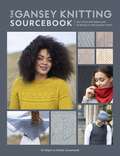
By Di Gilpin, Sheila Greenwell. 2021
Ganseys are hardwearing sweaters traditionally knitted for fishermen in and around the British Isles. Today, the styling and history of…
ganseys is as popular as ever and this collection of stitch patterns and projects brings the history of ganseys to a new audience. Learn all about the techniques used for knitting ganseys with this comprehensive sourcebook from experts in the subject, Di Gilpin and Sheila Greenwell. Di and Sheila are knitwear designers and makers based in Scotland where they teach regular workshops on traditional gansey techniques. Discover all the techniques you need to make an authentic gansey sweater with their special features which were developed for warmth and comfort in what were often, harsh conditions out at sea. Ganseys were designed with a special under arm gusset and a shoulder seam which prevented chaffing and improved movement for the wearer even when the jumper got wet and heavy. The authors explain these techniques with step-by-step instructions and artworks so you can replicate these details in your own work. Another key element to the gansey is the stitch pattern which was specific to the local area and often had a symbolism beyond the pattern itself and, some hoped, would act as a charm to keep the fishermen safe while they were out at sea. This collection features a comprehensive directory of 150 gansey stitch patterns so you can choose your favourite designs and motifs and learn which patterns were important to the fishermen in different areas. There are also 10 patterns for garments and accessories so you can practise your skills. The projects include a child's traditional gansey sweater so you can try out your skills on a traditional sweater but on a small scale. There are also some contemporary takes on the traditional gansey using lighter weight yarn and design details: these include a beautiful sweater with a gansey yoke; a contemporary take on the fisherman's kep; a gansey stitch cowl; a pair of mittens and socks; and light linen tank top. The smaller projects such as the mittens and hats are great for practising your skills before you attempt one of the larger projects.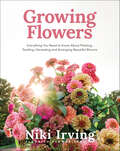
Master Flower Gardening and Learn to Grow Flowers for All Seasons&“Anyone wanting to get started with a flower garden will…
find plenty of expert guidance here.&” ―Publishers Weekly#1 Best Seller in Annual Flowers Gardening, Bulb Flower Gardening, and Perennial GardeningMaster the art of cultivating cut flowers, from seed to stunning arrangements, with this indispensable guide for gardening novices and pros alike.Create botanical beauty. Niki Irving&’s Growing Flowers whisks you away to the serene mountains of Asheville, NC, where her boutique flower farm thrives. Learn to grow florets and cut flowers with the same sustainable, natural practices Niki employs on her mountain-fresh farm. Boost your horticultural skills. This garden journal not only introduces you to the pleasures of growing a cutting garden but also guides you to arrange your flowers into simple-yet-gorgeous bouquets. Immerse yourself in the enchanting world of flower farming and discover techniques using not just blooms and greenery, but even artichokes, vines, and berries. Inside, you'll find: Practical guidance on organic flower gardening, from selecting the right seeds and seedlings to mastering seasonal rotation Insightful techniques for arranging cut flowers Tips and tricks from Niki Irving's successful boutique flower farm for cultivating your own cutting garden Engaging photographic content that transforms the book into a delightful coffee table addition Growing Flowers is a wonderful addition to any collection of garden books. If you&’re looking for gardening gifts for gardeners or enjoy flowering plant books and flower books like Floret Farms Cut Flower Garden book, Floret Farm's A Year in Flowers, or The Flower Gardener's Bible, you&’ll love Niki Irving's Growing Flowers.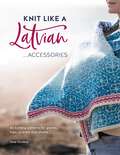
By Ieva Ozolina. 2021
Knit stunning accessories like gloves, hats, scarves and shawls featuring Latvian motifs with this collection of colorwork knitting patterns and…
charts.Another stunning collection of knitting patterns for colorwork accessories from Knit Like a Latvian author Ieva Ozolina.Choose from forty knitting patterns for hats, ear warmers, gloves, scarves, shawls, and wraps—all with distinctive Latvian designs and motifs.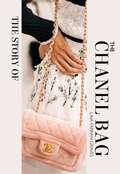
By Laia Farran Graves. 2023
Timeless and ever-fashionable, the Chanel handbag is the luxury goods statement piece that is always in demand. Since the launch…
of the 2.55 in 1955, Chanel has unveiled a curated classic selection of styles that has reached iconic stature – and here you will discover their myriad seasonal adaptations, limited editions and special features.From the ultra-rare beaded lucite Cage Flap to the discontinued Diana (named after Princess Di), the So Black to the Graffiti backpack, the book traces the rise of the Chanel bag from the very first designs to today's releases and charts the Chanel bag in popular culture and celebrity fashion.A detailed behind-the-scenes look at the craftsmanship explains the details of quilting, leathers and materials, hardware, labels and stitching, as well as how to authenticate a Chanel bag. Whether you are considering buying retail or second-hand, to celebrate a milestone, commemorate an important event in life or as an investment, this is your ultimate guide to this exclusive – and sometimes elusive – accessory.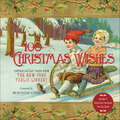
By The New York Public Library. 2018
A treasure trove of vintage Christmas cards, 100 Christmas Wishes is the perfect holiday treat from the New York Public…
Library.Every year as the days grow shorter, amidst the holly, cookies, and carols there is another timeless holiday tradition—sending and receiving Christmas cards to and from those you love. 100 Christmas Wishes is a collection of vintage holiday cards, all from the archives of the New York Public Library. The Library houses one of the greatest collections of early Christmas postcards from around the world with thousands of cards depicting every imaginable holiday scene. Archivists selected one hundred of the best cards from the extensive collection to share in 100 Christmas Wishes. From the elegant, gilded Santa Clauses and statuesque angels, to yuletide still lifes, tumbling tots and puppies with bows round their necks, each card is a beautiful celebration of the holiday season. The book also includes six perforated postcards with reproductions of the designs so you too can share a vintage Christmas wish with friends and family on your list.As Rosanne Cash, a patron and friend of the Library as well as a devoted fan of Christmas cards, says in her introduction “This collection of early Christmas postcards, housed for a century in the New York Public Library archives, distills those abiding wishes for the holidays from revelers from long ago and faraway, in a wish for peace, joy, magic, bounty, family, and for light to be shone ‘round the world at Christmas, past and future.’”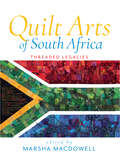
By Marsha MacDowell. 2024
In the southernmost region of the African continent, women have been piecing together materials—textile construction techniques commonly used in quilting—…
to create bed coverings throughout the history of the San and Khoi peoples. From the late seventeenth century through the early nineteenth century, an influx of Dutch, French, Indian, and British military personnel, traders, miners, and missionaries came to South Africa, bringing with them their own cultural traditions, including making and using quilts. Today, the making of quilts in South Africa is flourishing.Quilt Arts of South Africa stitches together the history, production, and significance of quilt making from its earliest appearance in the continent's southernmost region to the twenty-first century. With input from curators, linguists, art historians, activist artists, and folklorists, this book presents disparate yet connected inquiries into a wide-ranging history of the quilt. These perspectives connect a rich expressive art to place, showing how the quilting traditions in South Africa together reflect a unique cultural history and natural landscape.Itself pieced together from diverse voices, Quilt Arts of South Africa offers glimpses into the histories and meanings of quilting in South Africa.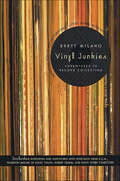
By Brett Milano. 2003
Not too far away from the flea markets, dusty attics, cluttered used record stores and Ebay is the world of…
the vinyl junkies. Brett Milano dives deep into the piles of old vinyl to uncover the subculture of record collecting. A vinyl junkie is not the person who has a few old 45s shoved in the cuboard from their days in high school. Vinyl Junkies are the people who will travel over 3,000 miles to hear a rare b-side by a German band that has only recorded two songs since 1962, vinyl junkies are the people who own every copy of every record produced by the favorite artist from every pressing and printing in existance, vinyl junkies are the people who may just love that black plastic more than anything else in their lives. Brett Milano traveled the U.S. seeking out the most die-hard and fanatical collectors to capture all that it means to be a vinyl junkie. Includes interviews with Thurston Moore of Sonic Youth, Peter Buck from R.E.M and Robert Crumb, creator of Fritz the cat and many more underground comics.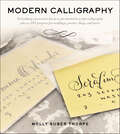
By Molly Suber Thorpe. 2013
A perfect gift for anyone who wants to learn the "write" way to craft calligraphy.Calligraphy is about creating something uniquely…
beautiful, whether to celebrate a special occasion like marriage or to use every day in the form of stationery. Author Molly Suber Thorpe, an award-winning wedding invitation designer and calligrapher based in Los Angeles, works closely with her international clients to give them the distinctive products they're looking for. In Modern Calligraphy, you can learn from this experienced expert how to master this fresh modern lettering style. The first book to teach this bold new style breaks the calligraphy process down into simple steps so anyone can learn to create their own stunning wedding invitations, thank you cards, gift tags, and more. Starting with an overview of the supplies—from paper to ink to pens—you will learn how to form letters, words, and then phrases by following Molly's clear step-by-step instructions, and by practicing with the provided templates. After mastering letter forms using a pointed pen and ink you can take it to the next level by learning how to use watercolor and gouache, or how to digitize your calligraphy. The twenty projects in the book provide lots of inspiration for making your own and are grouped into three sections: weddings, entertainment, and personal stationery. With loads of ideas, practice exercises, and helpful tips, soon you will be turning out gorgeous script calligraphy pieces like the ones featured in wedding magazines and popular websites like Pinterest.
By Cari Clement. 2007
Two of the hottest fashion trends in recent years---both embellishing and crocheting have emerged as sophisticated fashion influences. Embellished Crochet…
provides clear, illustrated instructions for all the fabulous embellishments included, with concise explanations and detailed step-by-step photos so you can either re-create them on the projects featured or use them as inspiration for your own designs. Each type of embellishment, from beading to embroidery to embellishing with braid, is shown in full-color close-up photography, with charts and stitch diagrams demonstrating how to work each step along the way.There are complete directions for making every crocheted project in the book. Organized by theme into six sections---Focus on Color, The Domino Effect, Out of Africa, Got the Blues, Orient Express, and Evening Elegance---each has a variety of projects from the simple to the more complex, ranging from bangles to bags to boleros.Jam-packed with innovative ideas and techniques for embellishing, this is a book that will appeal to all crocheters in search of new ideas and inspiration. And all are made in easy to work with and widely available Caron yarn.A wide variety of decoration, patterns, and embellishments adorn the beautifully crafted crocheted garments and accessories in this book conceived by Cari Clement, Caron Yarn's Director of Fashion and Design. You'll be thrilled with these delightful and appealing designs, from a variety of different knitwear designers---and all of the amazing designs are worked in widely available Caron International Yarns.Features:-clear, illustrated instructions for all the embellishments-concise explanations and detailed step-by-step photos-complete project directions for making every fabulous sweater, wrap, bag, and more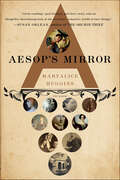
By Maryalice Huggins. 2009
"Everything I needed to know about Fox and Grapes mirror, I knew the moment I first saw it"What antiques restorer…
Maryalice Huggins knew when she stumbled across the mirror at a country auction in Rhode Island was this: She was besotted. Rococo and huge (more than eight feet tall), the mirror was one of the most unusual objects she had ever seen. Huggins had to have it.The frame's elaborate carvings were almost identical to a famous eighteenth-century design. Could this be eighteenth-century American? That would make it rare indeed. But in the rarefied world of American antiques, an object is not significant unless you can prove where it's from. Huggins set out to trace the origins of her magnificent mirror.Fueled with the delightfully obsessive spirit of Susan Orlean's The Orchid Thief, Aesop's Mirror follows Huggins on her quest as she goes up against the leading lights of the very male world of high-end antiques and dives into the historical archives. And oh, what she finds there! The mirror was likely passed down through generations of the illustrious Brown family of Providence, Rhode Island.Throughout history, mirrors have been seen as having mystical powers, enabling those who peer into them to connect the past and the future. In Aesop's Mirror, Maryalice Huggins does just that, creating a marvelous, one-of-kind book about a marvelous, one of-a-kind American treasure.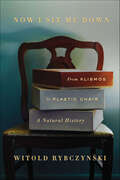
By Witold Rybczynski. 2016
Have you ever wondered where rocking chairs came from, or why cheap plastic chairs are suddenly everywhere?In Now I Sit…
Me Down, the distinguished architect and writer Witold Rybczynski chronicles the history of the chair from the folding stools of pharaonic Egypt to the ubiquitous stackable monobloc chairs of today. He tells the stories of the inventor of the bentwood chair, Michael Thonet, and of the creators of the first molded-plywood chair, Charles and Ray Eames. He reveals the history of chairs to be a social history--of different ways of sitting, of changing manners and attitudes, and of varying tastes. The history of chairs is the history of who we are. We learn how the ancient Chinese switched from sitting on the floor to sitting in a chair, and how the iconic chair of Middle America--the Barcalounger--traces its roots back to the Bauhaus. Rybczynski weaves a rich tapestry that draws on art and design history, personal experience, and historical accounts. And he pairs these stories with his own delightful hand-drawn illustrations: colonial rockers and English cabrioles, languorous chaise longues, and no-nonsense ergonomic task chairs--they're all here.The famous Danish furniture designer Hans Wegner once remarked, "A chair is only finished when someone sits in it." As Rybczynski tells it, the way we choose to sit and what we choose to sit on speak volumes about our values, our tastes, and the things we hold dear.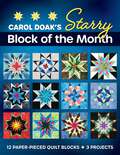
By Carol Doak. 2025
Paper piece perfection with Carol Doak's 12 Block of the Month stars! Paper piece stars like never before with Carol…
Doak’s 12 star Block of the Month! This booklet offers a curated introduction to paper piecing, featuring Carol’s expert instructions and a delightful selection of stars for each month. Mix and match the stars to suit your style, perfect for creating beautiful table runners and sampler quilts. Learn from best-selling author, inspiring teacher, and the Queen of Paper Piecing, Carol Doak This booklet is great for beginners, offering a quick introduction to paper piecing with Carol's stunning star blocks, just what you need to get started Use the 12 stars as a block-of-the-month challenge for yourself, your quilting circle, or your guild!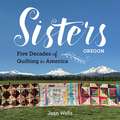
By Jean Wells. 2025
Explore the Sisters Outdoor Quilt Show through stunning visuals and compelling stories! Renowned as the world’s largest outdoor quilt show,…
the Sisters Outdoor Quilt Show in Sisters, Oregon, attracts more than 10,000 visitors annually to celebrate quilting artistry and craftsmanship. Explore the vibrant quilting community that gathers in this picturesque town, guided by the vision of quilters Jean and Valori Wells. Relive your experience or imagine your visit with this engaging overview of the show’s history, unique community ties, and stunning photos capturing memorable moments and quilt displays. Immerse yourself in hundreds of vibrant, full-color photos celebrating the rich history of the Sisters Outdoor Quilt Show The perfect souvenir for anyone who has attended this bucket-list event or dreams of going Explore the deep connections between the show’s founder, the town, the quilters, and the beautiful art of quilting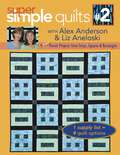
By Alex Anderson, Liz Aneloski. 2008
1 supply list = 9 quilt options • 9 new Super Simple quilt projects combine 3 incredibly easy quilt designs…
with 3 vibrant fabric styles: New Retro, Batiks, and Plaids and Stripes • Simple shopping-make any of the quilts from one supply list • Simple piecing-put the quilts together fast with easy strips, squares, and rectangles • Simple projects-quick and easy for both beginners and experienced quilters • Affordable price makes this book perfect for bundling in shop-created kits You loved how fast and easy it was to make the first Super Simple quilts. Now Alex and Liz are back with 9 all-new Super Simple projects just for you. Choose from 3 easy designs in 3 vivid color schemes. Add 3 simple quilting techniques and 3 quick ways to bind and finish. What could be simpler?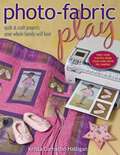
By Krista Camacho Halligan. 2009
Create Personalized Mementos for Your Favorite People • Turn favorite pictures and objects into one-of-a-kind gifts to treasure • 13…
fun projects easy enough to complete in a day or a weekend • Personalize your projects the easy way with your digital camera, scanner, printer, or all-in-one Give someone you love the best gift of all-good memories. These 13 easy projects include a scrapbook quilt with photos of favorite people, a wallhanging that displays a child's artwork, a word-and-picture quilt for beginning readers, a growth chart, scrapbook pages, a scrapbook clock, and other clever ways to display photos and treasured objects through printing on fabric.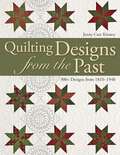
By Jenny Carr Kinney. 2008
Make Your Quilts Look Like Antiques with Authentic Period Quilting Designs • Over 300 historically accurate quilting designs, organized into…
four time periods to make it easy to find the right designs for your quilt • Essential reference guide for anyone interested in vintage and antique quilts • Designs for all skill levels, from beginner to advanced • Use for hand or machine quilting You've created a beautiful quilt top in the style of your favorite era. But how do you quilt it? This huge collection of historic quilting designs has the answer. With hundreds of designs gathered from old quilts, patterns, books, magazines, and other original sources, you'll find the perfect quilting design to make your quilt look like it was created generations ago. *Important Note about PRINT ON DEMAND Editions: This title will be printed after purchase and will arrive separately from any in-stock items. Please allow approximately 2 weeks for USA delivery, with an additional 2 weeks for international shipments. Expedited shipping is not available on POD Editions. The printing quality in this copy will vary from the original offset printing edition and may look more saturated due to printing on demand by a high-quality printer on uncoated (non-glossy) paper. The information presented in this version is the same as the most recent printed edition. Any pattern pullouts have been separated and presented as single pages.